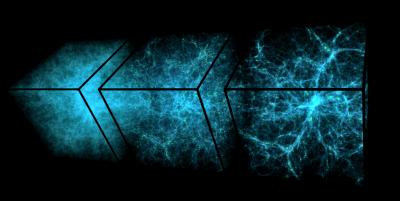Is dark energy hidden in the husks of burned-out stars?
The idea that the expansion of the universe is accelerating is taken as fact today. The cause is a repulsive form of energy, dark energy. But its nature remains a mystery. Now, a team of researchers at the University of Hawai’i in Mānoa have made an interesting prediction in The Astrophysical Journal: dark energy, which is responsible for this accelerated growth, could originate from a giant sea of compact objects spread out in the cavities between galaxies.
Since the mid-1960s, physicists have known that the collapse of stars might not produce true black holes, but instead so-called “GEneric Objects of Dark Energy” (GEODEs). In contrast to black holes, GEODEs fit very well into Einstein’s equations, because they don’t contain singularities. Instead, a rotating layer surrounds a core made from dark energy. From the outside, GEODEs and black holes appear very, very similar. This also applies particularly when the “noise” of their collisions is measured with a gravitational wave detector.
Because GEODEs imitate black holes in this respect, it was also assumed that they moved through space the same way as black holes. “This becomes a problem if you want to explain the accelerating expansion of the universe,” said Kevin Croker, lead author of the study. “Even though we proved last year that GEODEs, in principle, could provide the necessary dark energy, you need lots of old and massive GEODEs. If they moved like black holes, staying close to visible matter, galaxies like our own Milky Way would have been disrupted a long time ago.”
That, however, is not the case. The researchers discovered that the rotating layer around each GEODE determines how the objects move relative to each other. If their outer layers rotate slowly, GEODEs clump together more quickly than black holes. This is because GEODEs gain mass through the growth of the universe itself. For GEODEs with layers that rotate close to the speed of light, however, the growth of mass is dominated by a different effect and the GEODEs start to repel each other. “The dependence on spin was really quite unexpected. If confirmed by observation, it would be an entirely new class of phenomenon.”
The team solved Einstein’s equations under the assumption that many of the oldest stars that were born when the universe was less than 2% of its current age formed GEODEs when they died. Because these old GEODEs fed on other stars and abundant interstellar gas, they began to spin very rapidly. As soon as they were spinning quickly enough, the GEODEs mutual repulsion caused most of them to move away into regions that would eventually become the empty voids between today’s galaxies.
GEODEs could thus solve the problem of dark energy, while simultaneously remaining in harmony with different observations across large distances. GEODEs stay away from today’s galaxies, so they do not disturb delicate star pairs counted within the Milky Way. The number of old GEODEs needed to solve the dark energy problem is also consistent with the number of old stars. Therefore, GEODEs do not disrupt the measured distribution of galaxies in space, because they had already separated from luminous matter before today’s galaxies formed. Finally, GEODEs do not directly affect the gentle ripples in the afterglow of the big bang, because they were born from dead stars hundreds of millions of years after this cosmic background radiation was released.
All that is missing now is the direct proof of a single GEODE. The researchers hope to find a possible way to do this soon.
